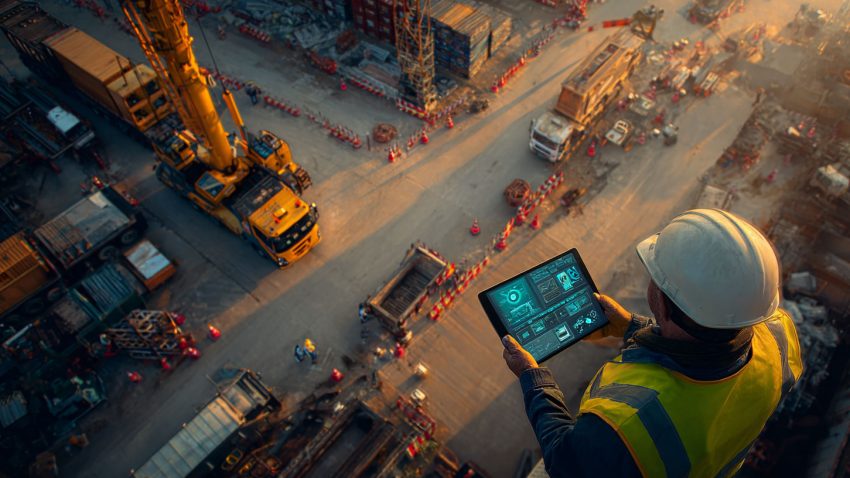Construction Site Safety: Top 15 Benefits of Real-Time Hazard Reporting Apps
Table of Contents:
Revolutionizing Construction Safety Management
In the construction industry, where the margin for error is small and the stakes are high, maintaining rigorous safety standards is crucial. As project complexity increases and regulatory requirements become more stringent, traditional methods of managing safety practices can fall short. Real-time hazard reporting apps represent a significant technological advancement, offering a dynamic and effective approach to managing safety risks that could otherwise lead to accidents and inefficiencies. These tools not only provide a platform for immediate incident reporting but also enhance the overall safety culture by actively involving every team member in safety practices. This article will delve deeper into how these apps are transforming the construction industry, making safety management more proactive, responsive, and data-driven.

Seamless Integration with Existing Safety Protocols
One of the most significant benefits of real-time hazard reporting apps is their ability to integrate smoothly with existing safety protocols without disrupting ongoing operations. These apps serve as an extension of a company’s current safety program, enhancing its effectiveness rather than overhauling it. By syncing with existing databases and safety management systems, they provide a more comprehensive view of safety trends and potential hazards across the site. This integration allows for a unified approach to safety management, where data from various sources is consolidated into a single, easy-to-access platform. Managers can oversee a holistic safety landscape, ensuring that nothing is overlooked and that all safety measures are consistently applied.
Promoting a Culture of Continuous Learning and Adaptation
Real-time hazard reporting apps do more than just track and manage immediate risks; they promote an organizational culture that values continuous learning and adaptation. By providing instant feedback and detailed analytics on reported incidents, these apps help identify not just isolated events but also underlying patterns that could indicate larger systemic issues. This insight enables management to devise targeted training sessions and refine safety protocols, thereby reducing the likelihood of repeated incidents. Furthermore, these tools encourage all employees to participate in the safety dialogue, fostering an environment where learning from past incidents is a shared responsibility and where every team member is empowered to suggest improvements.
Enhancing Worker Engagement and Morale
The introduction of real-time hazard reporting apps significantly boosts worker engagement and morale by democratizing the process of safety management. These apps empower workers by giving them a direct line to express their concerns and report potential hazards without bureaucratic delays. When workers see that their input has immediate effects—whether in the form of rapid response actions or changes to safety policies—it reinforces their sense of being valued and heard. This not only enhances their commitment to following safety protocols but also boosts overall job satisfaction. In environments where safety is clearly prioritized, workers are more likely to stay with the company, reducing turnover and fostering a more experienced and knowledgeable workforce.
Harnessing Technology for Safety Excellence
In today’s construction industry, safety is paramount. With the increasing complexity of construction projects and heightened regulatory scrutiny, managing safety effectively has never been more crucial. Real-time hazard reporting apps are revolutionizing safety management by enabling instant communication of potential risks and facilitating a proactive safety culture. These apps are part of a broader move towards Behavior Based Safety systems, where technology aids in maintaining high safety standards through immediate feedback and continuous improvement.

StruxHub
Discover how StruxHub can revolutionize your construction management. Contact us today!
Here, we explore the top 15 benefits of integrating real-time hazard reporting apps into your construction safety management strategy.
1. Immediate Hazard Notification
Real-time hazard reporting apps ensure that any potential danger or unsafe condition is reported instantly, allowing for swift action. This immediate reporting can significantly reduce the likelihood of accidents, enhancing worker safety and site security.
2. Quick Response to Safety Issues
With instant notifications, site managers and safety officers can respond to issues as soon as they arise, rather than during routine checks. This responsiveness can be crucial in preventing minor hazards from becoming serious incidents.
3. Empowered Workforce
These apps empower workers to take an active role in safety management. When employees can report hazards instantly, they feel valued and responsible, fostering a strong safety culture within the team.
4. Streamlined Safety Processes
By digitizing hazard reporting, these apps eliminate cumbersome paperwork and simplify the safety management process. This not only saves time but also reduces the risk of errors associated with manual entry.
5. Enhanced Compliance with Safety Regulations
Real-time data helps ensure that all safety measures comply with current regulations. Regular updates to the app can incorporate the latest legal requirements, keeping your safety protocols up-to-date.
6. Improved Safety Training
Using data collected from the app, trainers can identify common safety issues and tailor training programs to address these specific areas. This targeted training approach can significantly improve overall safety performance.
7. Detailed Record-Keeping
Every report made through the app is stored securely in the cloud, providing a detailed and auditable record of all safety incidents and actions taken. This comprehensive data is invaluable during inspections and audits.
8. Reduced Safety-Related Costs
Preventing accidents not only saves lives but also reduces costs related to healthcare, legal issues, and equipment damage. Effective hazard management through real-time reporting can lead to substantial financial savings.
9. Data-Driven Decision Making
The data collected through these apps provide valuable insights into safety trends and risk patterns. This information can guide decision-making and help prioritize safety investments.
10. Increased Transparency in Safety Operations
Real-time reporting apps increase transparency by making safety data accessible to all stakeholders, including management, workers, and external auditors. This openness builds trust and improves compliance.
11. Enhanced Public and Employee Confidence
A robust safety system, underpinned by technology, enhances the reputation of a company. Knowing that safety is taken seriously makes the workplace more attractive to potential employees and can improve public perception.
12. Integration with Other Safety Systems
Many real-time hazard reporting apps can integrate seamlessly with other safety and operations management systems. This integration creates a cohesive safety network across the site.
13. Scalability
As construction projects vary in size, the flexibility to scale safety operations is essential. Real-time hazard reporting apps can easily scale up to cover large projects or multiple sites, ensuring consistent safety management.
14. Promotion of a Proactive Safety Culture
By making hazard reporting easier and more effective, these apps promote a shift from reactive to proactive safety measures, where preventing incidents becomes the norm.
15. Continuous Improvement in Safety Practices
Finally, the ongoing analysis of hazard data facilitates continuous improvement in safety practices. Insights gained from real-time reporting can lead to innovative solutions that enhance safety further.
A Strategic Asset for Modern Safety Management
The integration of real-time hazard reporting apps into construction safety management is more than just a technological upgrade—it is a strategic enhancement that touches every aspect of operations. These apps provide a direct, immediate means to manage risks, engage workers, and build a proactive safety culture. As the construction industry continues to evolve, adopting such innovations becomes essential for companies aiming to maintain competitive advantage, comply with regulatory demands, and most importantly, ensure the safety and well-being of every team member.
StruxHub is at the forefront of transforming construction management with its innovative, user-friendly platform designed to streamline operations, enhance on-site safety, and improve project efficiency. By integrating cutting-edge technology with practical, real-world applications, StruxHub provides a holistic solution to the complex challenges faced by today’s construction professionals. Our platform is built to ensure seamless collaboration, meticulous resource management, and unparalleled project oversight, making construction projects more manageable and predictable than ever before.
StruxHub’s Key Features and Benefits:
- Advanced Delivery Management: Automate and optimize your delivery schedules, ensuring materials arrive just in time, every time.
- Site Communication: Utilize georeferenced maps and instant messaging to keep every team member informed and aligned.
- Construction Materials Management: Track inventory levels and manage materials procurement with ease, reducing waste and avoiding project delays.
- Construction Safety & Inspection Workflows: Implement customizable mobile forms for conducting safety inspections and managing compliance documentation effortlessly.
- Short-Term Scheduling: Visualize project tasks with detailed floor plans, linking each activity to specific locations for better planning accuracy.
- Construction Resource Management: Efficiently allocate personnel and equipment, maximizing productivity and reducing idle time.
StruxHub’s Product Offering:
- StruxHub Deliveries: Simplifies the coordination of incoming deliveries, ensuring materials and equipment are precisely timed to project needs.
- StruxHub Logistics: Offers intelligent site logistics planning, from crane scheduling to space allocation, for smoother operations.
- StruxHub Safety: Elevates on-site safety standards with easy-to-use tools for inspections, permits, and incident reporting.
- StruxHub Scheduling: Enhances project timelines with intuitive scheduling tools that ensure tasks are completed efficiently and on time.
With StruxHub, construction companies can look forward to a streamlined, more efficient project execution that delivers on time and within budget. Embrace the power of innovation and take your construction projects to the next level.
Don’t miss out on the opportunity to optimize your construction management processes with StruxHub. Sign up for a free demo today. Let’s build smarter, together.



